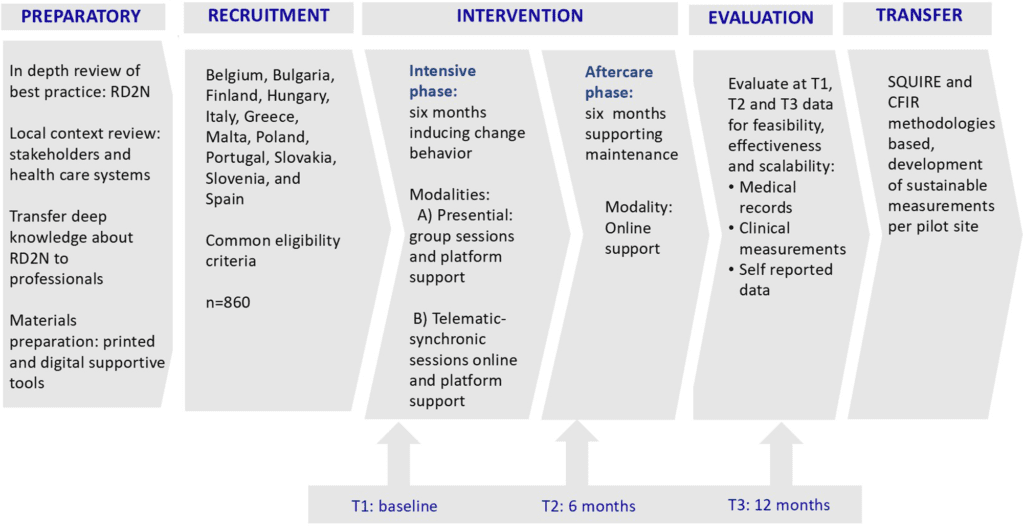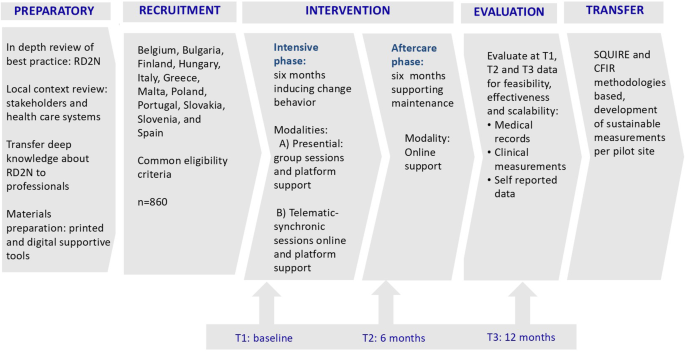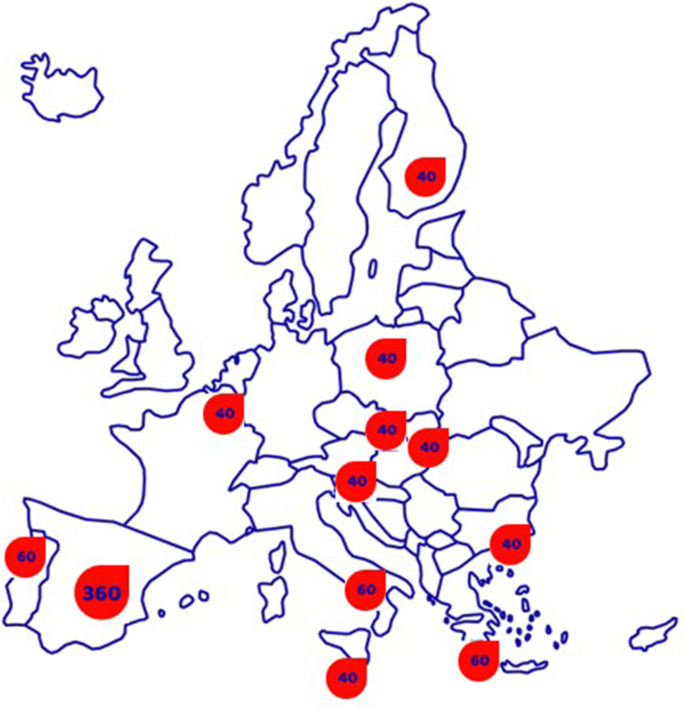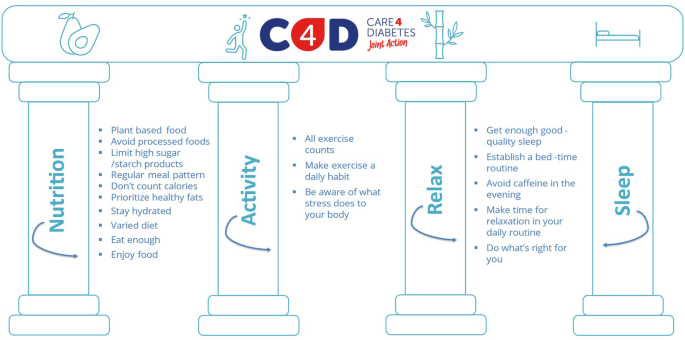Design and ethical considerations
C4D will be a one-group pre-test/post-test quasi-experimental study, conducted in concert in 12 countries. Briefly, C4D will evaluate the acceptability and efficacy of an innovative multicomponent intervention addressing several lifestyle behaviours (i.e. nutrition, physical activity, sleep, and stress management), that can trigger the achievement of long lasting body weight control, healthy glucose levels, lowering -and in some cases interrupting- medication consumption, reducing comorbidities, complications and associated healthcare costs, and improving health-related quality of life. The intervention will be based on the “Integrated Model for explaining motivational and behavioural change” (I-CHANGE model) and will focus on improving participants’ skills – not just knowledge – to manage relevant components of their lifestyle [26]. The structured implementation process, including training and capacity building of healthcare personnel and cultural adaptation according to local situation, aims to produce a sustainable lifestyle care model that can be scaled up nationally. Each country/partner will have a local multidisciplinary team in charge of driving the process, consisting of at least a diet expert, registered nurse or general practitioner, a coach, facilitator or equivalent and a lead coordinator (Table 1). The C4D will run from February 2023 to January 2026.
The study has been approved by an ethics committee (EC) in each participating country to conduct the activities in accordance with EU ethical standards. Study participants must sign the informed consent form before starting the proposed activities. Previously, they will have received, through an information sheet and interview with the assigned professional of reference, all the related information, as to resolve any doubt that may arise beforehand. Since behavioural changes are expected from the beginning of the program, the first pharmacological reduction of antidiabetic agents should be carried out early during the first intervention sessions unless EC and/or clinicians recommended differently for a specific country. Further medication modifications will be made during the program based on the biometric levels of the participants. Thereby, C4D will be implemented under strict (and continuous) medical supervision.
Stages/Sequencing actions
The study protocol is divided in different stages and each of them applies different approaches to ensure its scientific soundness (Fig. 1).
Preparatory actions
The challenge of transferring a particular contextualized successful practice into a different environment along the EU requires a deep knowledge of the original RD2N best practice. But at the same time, the uniqueness of each context needs to be analysed to provide the best opportunity to transform RD2N best practice into a local real possibility. Therefore, preparatory actions include a comprehensive analysis of general aspects to be considered by the local teams when adapting, implementing, monitoring, and evaluating the RD2N best practice. They also involve the examination of country-specific circumstances, including key stakeholders’ identification as local facilitators of the entire process. Different methodologies will be applied: (a) SCIROCCO [27], self-assessment tool which will be used to identify the maturity of the health and social care systems, for the adoption and scaling up of integrated care, or best practice solutions; (b) Consolidated Framework for Implementation Research (CFIR), a construct to analyse determinants [28]; it is designed to describe barriers and facilitators to implementation outcomes; (c) SQUIRE 2.0, a framework for reporting new knowledge about the actions and how to improve healthcare [29]; (d) SWOT analysis (acronym of strengths, weaknesses, opportunities and threats), a technique for assessing the national, regional and local contexts, including stakeholders [30], which can help to analyse what each partner does best now, and to devise a successful strategy for the future.
During this preliminary stage, up to 120 healthcare professionals (i.e. up to 10 per country) are directly trained by Dutch RD2N best practice owner for their actions in their countries. The training is designed online over 5 sessions with all selected members of the multidisciplinary team per each country (together), that will receive the “know how” to transmit to people with T2DM the fundamental elements of the intervention. Three formations have been planned with four countries in each formation to effectively deliver the training. Then, local multidisciplinary team members will adapt the content and materials to their respective local languages and context. The main materials that need adaptation are: the participant’s book, recipe book, formative content of the intervention sessions and entries on the digital platform.
Recruitment of participants
People with a physician-diagnosed T2DM will be invited by the healthcare worker in charge of their follow-up, who will previously determine the compliance with selection criteria. A candidate will be considered for participation if he/she meets all eligibility criteria (Table 2). People already selected must be informed in detail about their participation and commitments and signed the consent form; they must fill in baseline registration forms to be compared with new forms required as their participation progresses.
According to C4D study protocol, 860 people living with T2DM are expected to be recruited, with a minimum of 40 participants per country (Fig. 2). An estimation was done considering body weight as main outcome. Based on the 6-month body weight reduction results from the original best practice, with standard deviation of 5.1 kg, we can estimate that a sample size of 40 participants is sufficient for a paired sample t-test (power of 80%, type 1 error rate 0.05), assuming the true effect size (mean reduction in body weight during the first 6 months) is 2.3 kg. Therefore, 860 participants will be enough to test the hypothesis involving health-related quality of life.
Intervention
Although C4D adapts the intervention features to country-specific guidelines, contexts and needs, there is an overall approach to achieve a robust, structured framework. The intervention consists of a T2DM self-management education and support group program [31], based on the I-Change model [26], and developed over 12 months, the program consists of two phases: an intensive phase followed by an aftercare intervention, each lasting 6 months.
The intensive phase provides participants with theoretical content and practical activities on the 4 pillars – nutrition, physical activity, sleep and relaxation – of RD2N best practice (Fig. 3). Activities and workshops related to this content include interpretation of changes in glucose levels throughout the day, biometric feedback, physical exercises, relaxation and coaching practices, and cooking classes. C4D provide people living with T2DM with skills for incorporating healthy habits into their lifestyles in an experiential dynamic way (i.e. participants must ‘live’ and practice the concepts they receive during the theoretical sessions). For pedagogic and organizational reasons people living with T2DM will be organized into groups of 20 people approximately.
The intensive phase tests two different delivery modes with identical content, one face-to-face and the other telematic, supported by a digital platform in both cases. The face-to-face modality refers to interventions consisting of about 6 on-site group training sessions over 6 months. A novel aspect of C4D is the inclusion of an overnight stay in order to: (a) promote group bonding, through joint acquisition of the knowledge received and its practice; (b) focus attention, by taking participants out of their own environment, responsibilities and situation at home; (c) aid follow-up, as the stay would allow for greater control over program follow-up (fewer triggers in the program environment, such as e.g., snacking); (d) guarantee for safety, as participants would feel physically and emotionally safe (especially participants on hypoglycaemic medication); (e) ease the burden, as the two start days are fully scheduled and intensive. Conversely, the telematic modality refers to several fully digital group sessions. The online platform will offer support throughout the duration of both intervention modalities, including coaching, close personal advice, and physician-monitoring of medication use.
The aftercare intervention over the following 6 months ensures that barriers are removed, and new habits become sustainable over time. Integrating T2DM self-care into daily life is a challenge for participants and their families. Therefore, individual participant characteristics, social determinants of health, and psychosocial factors should be part of the person-centered care, respecting, and responding to their individual preferences and barriers [1].
Evaluation
C4D includes three types of evaluation: impact, process and economic evaluation.
The impact of the intervention will be assessed in terms of behavioural change, participant clinical characteristics related to people living with T2DM (anthropometric measures, biomarkers, medication use, etc.) and quality of life. Measurements will be taken at three time points: T1: baseline (prior to the beginning of the intervention); T2: between the intensive and aftercare phases (6 months); and T3: immediately after the end of the intervention (12 months). Trained staff using standardised methods will collect study variables, like laboratory and clinical measurements, and self-report questionnaires (Table 3); agreed validated questionnaires will be requested and made available when appropriate. The survey will be available in English and needs to be translated into local languages. The translation and translation-back process and contextual adaptation will be used to ensure compatibility with the original questionnaires adapting to regional characteristics.
The process evaluation considers the satisfaction and experience of participants and staff, using a self-reported questionnaire. The evaluating process follow the RE-AIM framework (Table 4). In addition to the quantitative parameters, qualitative data collect factors influencing participation/non-participation; elements contributing the outcomes; the barriers preventing adoption (both by care providers and participants); how was the intervention implemented; and what will be sustained, discontinued, or adapted, and why.
Socio-demographic characteristics such as sex, age, education, immigrant background, cohabitation and income level will be analysed.
C4D will collect data on the costs, and the economic impact of the implemented practice, comparing the intervention costs against the benefits of the practice (e.g. quality of life measured with the validated questionnaire). Economic data collection will include the transfer and adaptation costs of the program per country and the implementation phase. Transfer and adaptation data will include developing the online platform, translating and adapting the materials, planning the practicalities of the intervention and training the trainers. The implementation costs will include labour (cost of training staff to deliver the intervention and the personnel cost of the actual intervention), capital (the cost of renting spaces to undertake practice’ activities), administrative (the cost of promoting the intervention to eligible participants), consumables (other materials, tools, goods needed for the intervention implementation) and overhead costs.
Quality control
Two different tools, proven effective during previous European projects are included to assure quality control. During the intervention, PDSA methodology [32], acronym of “plan, do, study and act” ensures to make corrections and fine-tune the design for future use. The second tool will be the Standards for Quality Improvement Reporting Excellence (SQUIRE) [33], which are a set of 19 descriptive units that present how to examine and develop quality improvements in healthcare. The guidelines were developed over the years to respond to the insufficient and limited studies published in this field. They have proven to be useful designing implementation, and for writing communications.
Transfer
The Consolidated Framework for Implementation Research (CFIR) [28] will be used to examine factors influencing different levels of care delivery (patient care, delivery groups, health organisation or policy) that could hinder or facilitated the implementation of the best practice in C4D. The CFIR offers some constructs that have proven effective during the implementation. It is adaptable to a variety of contexts and settings, and covers five key domains: the intervention, the internal and external environment, the people involved, and the implementation process itself. Each domain comprises multiple constructs that interact in complex ways to influence the effectiveness of implementation. CFIR provides the multidisciplinary teams with a specific methodology to identify relevant factors influencing implementation and increasing their potential success rate for future implementations.




